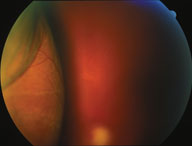 Choroidal detachment occurs when the retina and choroid become lifted from the sclera by an accumulation of either serous fluid or blood. For this reason, a choroidal detachment is often secondary to another ocular condition.
Choroidal detachment occurs when the retina and choroid become lifted from the sclera by an accumulation of either serous fluid or blood. For this reason, a choroidal detachment is often secondary to another ocular condition.
(a) Serous choroidal detachment is often related to low intraocular pressure (hypotony) following surgery or trauma, or secondary to inflammation. Low intraocular pressure (IOP), particularly <5mmHg, is liable to promote transudation of serum out of the choroidal vasculature, causing lifting of the choroid.
(b) Haemorrhagic choroidal detachment may also follow surgery or trauma, or from an abnormal vasculature such as choroidal neovascularisation. Surgery or trauma may cause rupture of the short posterior ciliary arteries or other vascular trauma leading to bleeding.
(c) Choroidal detachment in the absence of apparent cause has been termed uveal effusion syndrome or idiopathic ciliochoroidal effusion.
Symptoms
Choroidal detachment may be asymptomatic or be associated with decreased vision. Pain may be associated with haemorrhagic choroidal detachment and in severe serous choroidal detachment.
Register now to continue reading
Thank you for visiting Optician Online. Register now to access up to 10 news and opinion articles a month.
Register
Already have an account? Sign in here
